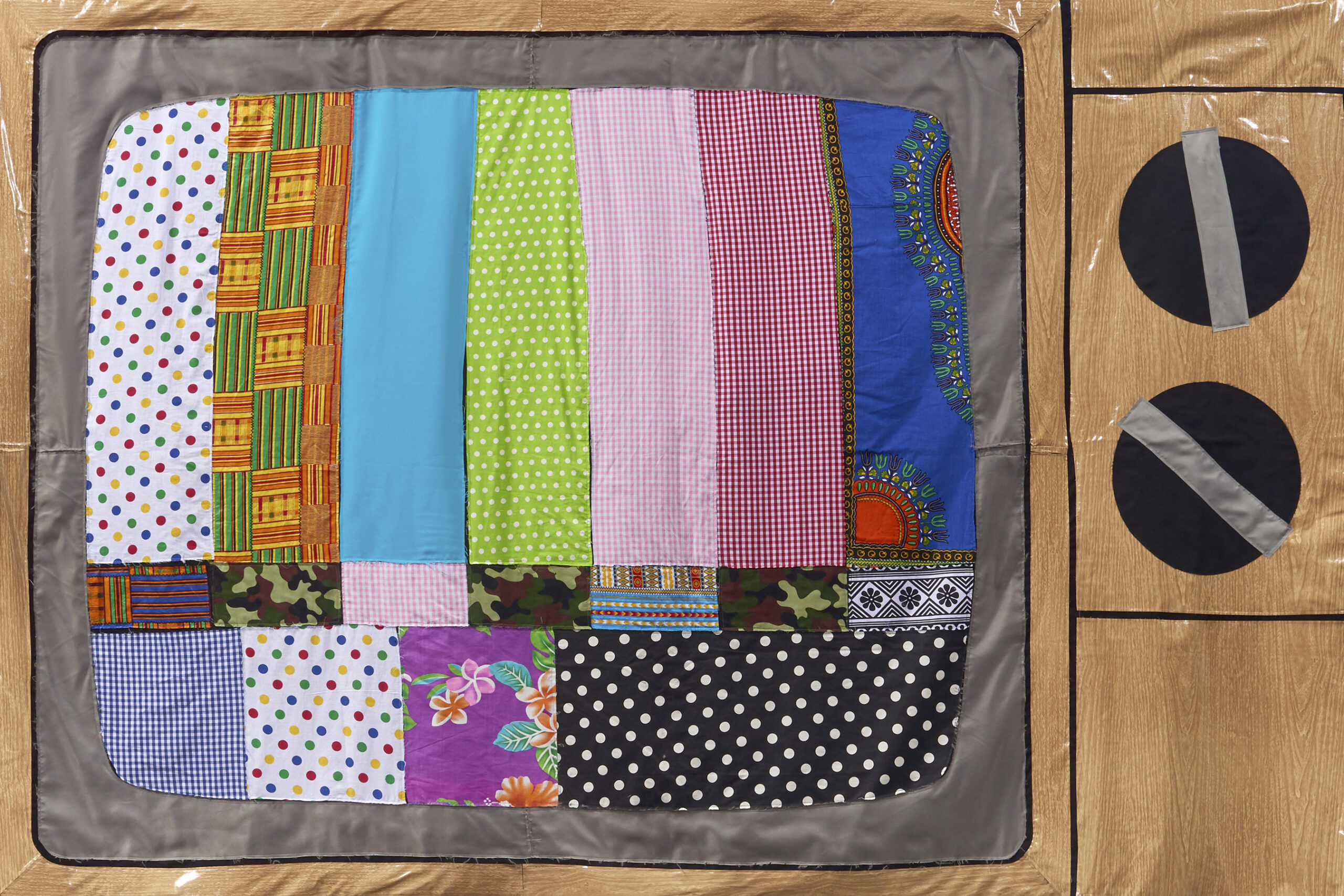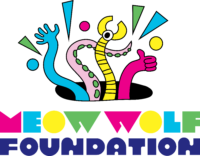Night At…MCA Denver

Derrick Adams, Fabrication Station #4, 2016. Fabric wall sculpture, 72 x 108 inches. Courtesy the artist and Vigo Gallery, London.
CBCA Members and their employees are eligible for two complimentary tickets to enjoy a summer evening at the Museum of Contemporary Art (MCA) Denver. Attendees will get to experience three different exhibitions.
- Derrick Adams: Transmission
- Lisa Oppenheim: Spine
- Kristen Hatgi Sink: Honey
Learn more about each exhibition below.
CBCA distributes tickets on a first come, first served basis. Night At… events are open to all employees of CBCA Member companies and their employees.

Derrick Adams
Transmission
The sculptures, installations, and works on paper included in this exhibition illustrate American artist Derrick Adams’ ongoing study of racial identity as it is both filtered through popular culture and also reimagined for the future. Each body of work featured in this exhibition highlights a particular strain of Adams’ sharp yet unexpectedly playful representations of figures both real and imagined, from the past and the future.
Included in Transmission is his series of Boxhead sculptures depicting androgynous figures as viewed through an analog TV set. Held within these tight frames, the figures seem to burst forth from their boxes. Adams presents these faces as though from multiple viewpoints, toying with their flatness and suggesting that such portrayals on television might do better by endowing their characters with more dimensionality. His interactive sculptures On invite viewers to perform their own infomercials, using generic objects as stand-ins for consumer products similarly pitched to a captive audience via television and the internet. Another interactive installation completes this survey of Adams’ work: Future People. A video projection transports viewers who are sitting in specially designed chairs on a platform into an imagined future. Passing through constellations of objects in a sci-fi setting, the viewer journeys to a particular future—one that is inspired by far-ranging sources related to AfroFuturism.
Adams offers a future that fuses sci-fi elements with historically significant objects from his close study of the archives at Chicago’s Stony Island Arts Bank. The archives there preserve the Johnson Publishing Archive, and the Edward Williams’ collection of negrobilia (mass cultural objects depicting stereotypical images of black people), as well as Frankie Knuckles’ record collection. Adams’ approach to artmaking is at once generous and inviting, and though it is often inspired by real world objects, he takes a much more handmade approach to his artmaking. As he notes, “I like materials with a physical appearance. Imagination is in everyone, and if you can envision things and not worry about high production, you can do more and affect people in a way that’s equally relevant and impactful.”
Derrick Adams was born in 1970 in Baltimore, Maryland. He lives and works in Brooklyn, New York. His multi-disciplinary practice includes performance, video, sound, collage, and sculpture. A recipient of a 2009 Louis Comfort Tiffany Award, and 2014 S.J. Weiler Award, Adams received his MFA from Columbia University, BFA from Pratt Institute, and is a Skowhegan and Marie Walsh Sharpe alum. Recent exhibitions include: Greater New York '05, MoMA PS1; Open House: Working In Brooklyn '04, Brooklyn Museum of Art; PERFORMA ‘05, ‘13, ‘15; Radical Presence & The Shadows Took Shape, Studio Museum in Harlem; and The Channel, Brooklyn Academy of Music. His work is in the permanent collections of The Metropolitan Museum of Art, Studio Museum in Harlem, Virginia Museum of Fine Arts, and the Birmingham Museum of Art.
The exhibition is curated by Nora Burnett Abrams, Ellen Bruss Curator and Director of Planning.
The exhibition is generously supported by Jim and Julie Taylor.
Image: Derrick Adams, Fabrication Station #4, 2016. Fabric wall sculpture, 72 x 108 inches. Courtesy the artist and Vigo Gallery, London.

Lisa Oppenheim
Spine
For the exhibition Spine, Lisa Oppenheim repurposed photographs from Lewis Hine, a photojournalist from the early 20th century. Hine’s images dwell on the conditions of immigrant and child labor in American mills and factories from that time. Oppenheim appropriated specific works by Hine from the Library of Congress’ photographic archive that depict adolescent textile workers—primarily young women with physically misshapen backs. Hine originally documented these figures to illustrate the damaging effects of textile manufacturing on the spine. Oppenheim printed the images life-sized and bisected each image at the vertical points of the figure’s spine, effectively collapsing the subject and the photograph together.
Two other series complete this survey of Oppenheim’s recent work: Remnants creates photographs from textile fragments the artist sourced from the same time period as Hine’s photographs; and Jacquard Weave, which features textile works woven from the same vintage fragments. With each inversion, the colors reverse: the photograph is the color negative of the original textile, whose colors are again inverted in Jacquard loom compositions. With these two series, Oppenheim both borrows and translates troubling issues of the past into timely metaphors around labor, production, and craft today.
Lisa Oppenheim (b. 1975, New York, NY) lives and works in Brooklyn. She received a BA in art and semiotics from Brown University in 1998 and an MFA in film and video from Bard College,
Annandale-on-Hudson, New York, in 2001. She attended the Whitney Museum of American Art Independent Study Program for studio art in 2003. In 2014, Oppenheim was the recipient the AIMIA|AGO Photography Prize from the Art Gallery of Ontario and the Shpilman International Photography Prize from the Israel Museum. Recently, she has been the subject of solo exhibitions at MOCA Cleveland (2017), the FRAC Champagne-Ardenne (2015), and group exhibitions including New Photography at The Museum of
Modern Art (2013). Her work is held in the permanent collections of the Museum of Modern Art, New York; The Solomon R. Guggenheim Museum, New York; The J. Paul Getty Museum, Los Angeles; The San Francisco Museum of Modern Art; Centre Georges Pompidou, Paris; Israel Museum, Jerusalem, among others.
This exhibition is organized by the Museum of Contemporary Art Cleveland and curated by Andria Hickey, Senior Curator.
Image: Lisa Oppenheim, Remnant (Machine Lace, Double Exposure), 2017. C-print. 41 1/8 X 30 1/4 inches. Courtesy the artist and Tanya Bondakdar, New York.

Kristen Hatgi Sink
Honey
Honey is an exhibition of new work by Denver-based photographer Kristen Hatgi Sink. Sink has created a series of videos featuring the exhibition’s eponymous sticky substance—dripping and pouring over composed objects and human subjects. In them, flowers, fruit, and a young woman remain nearly motionless as honey runs over their respective delicate forms. Their inertia and Sink’s composition and use of a cold, bright light recall traditional styles of painting such as the portrait or the still-life. In the middle of the gallery, and in contrast to the videos’ delicate imagery, sits an austere, glass vitrine containing honey. A simple, geometric basin resembling a minimalist sculpture, the tank will be the setting for multiple performances taking place throughout the duration of the exhibition.
Honey furthers Sink’s work with natural materials through the medium of photography. She uses butterflies, flowers, insects, fruit, and fish, in addition to human subjects, to create baroque scenes. With the videos, vitrine, and performances she created for MCA Denver, she explores honey’s cultural significance. The substance represents wealth, nutrition, sexuality and love, health and healing, and sacred love. Its chemical properties make it a natural preservative and as such it can also be associated with death. More recently, it has become a symbol of environmentalism, as the threats to bees’ existence have become better understood. Sink’s use of honey suggests many of these meanings and the contradictions that exist among them.
Kristen Hatgi Sink was born in 1984 in Denver, Colorado, where she currently lives and works. She earned a BFA at the Art Institute of Boston at Lesley University in Cambridge, Massachusetts. Her work has been exhibited at venues across the country and abroad, including at the Boulder Museum of Contemporary Art, the Denver Art Museum, the Japanese Paper Museum Ino, and Cohju Contemporary Art.
This exhibition is curated by Zoe Larkins, Associate Curator at the Museum of Contemporary Art Denver.
Image: Kristen Hatgi Sink, Still from Honey, 2018. video, TRT 9:23. Courtesy the artist and Gildar Gallery, Denver.

